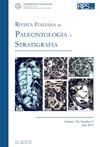FISH OTOLITHS FROM THE LATE MAASTRICHTIAN KEMP CLAY (TEXAS, USA) AND THE EARLY DANIAN CLAYTON FORMATION (ARKANSAS, USA) AND AN ASSESSMENT OF EXTINCTION AND SURVIVAL OF TELEOST LINEAGES ACROSS THE K-PG BOUNDARY BASED ON OTOLITHS
IF 1.9
3区 地球科学
Q2 GEOLOGY
引用次数: 11
Abstract
Otolith assemblages have rarely been studied across the K-Pg boundary. The late Maastrichtian Kemp Clay of northeastern Texas and the Fox Hills Formation of North Dakota, and the early Danian Clayton Formation of Arkansas therefore offer new insights into how teleost fishes managed across the K-Pg boundary as reconstructed from their otoliths. The Kemp Clay contains 25 species, with 6 new species and 2 in open nomenclature and the Fox Hills Formation contains 4 species including 1 new species. The two otolith associations constitute the Western Interior Seaway (WIS) community. It contains the earliest unambiguous representatives of the Gadiformes (cods and hakes) and the Heterenchelyidae (mud eels). The WIS community differs significantly from other Maastrichtian otolith assemblages previously studied from Mississippi and Maryland, which constitute the Appalachian community, with only 4 shared species (similarity percentage of 7.3%) between both communities. The difference is interpreted to be related to cold-water influence in the WIS community, which may have still been connected to the Arctic Basin, and to the depostional environment (muddy bottom) in the Kemp Clay. The Kemp Clay is unusually rich in taxa that survived the end-Cretaceous extinction event and are still present in the Danian of the Clayton Formation, or, as the case may be, in the Danian and Selandian of the boreal northern European community known from Denmark. Approximately 54% of all otolith-based teleost species identified from the Maastrichtian WIS community survived the K-Pg boundary event (versus 11-12% in other communities) and 73% of the genera (versus 40-50% in other communities). The early Danian Clayton Formation contains an impoverished inherited association with 14 species, of which 11 are survivors from late Maastrichtian times, 1 species is new, and 2 remain in open nomenclature. This compares to a significantly higher degree of newly evolved species in only slightly younger faunas from the middle to late Danian and Selandian of Europe indicating an initially slow pace of recovery. The observed differences in survival and the composition of survived and extinct taxa are discussed in the light of the ongoing discussions concerning the consequences and effects that led to the end-Cretaceous extinction event commonly thought to have been caused by a large meteorite impact. In our assessment, an ‘impact winter’ could have had a major influence on the live cycle of tropical to subtropical fishes while perturbations in the pelagic food web or ocean surface acidification might have had a minor and more selective effect. Overall, teleost fishes were significantly affected by the end-Cretaceous mass extinction, but to a much lesser extent than in many other biota. This study provides more evidence of the importance of Late Cretaceous otolith assemblages in the USA for interpreting teleostean evolution. The newly described taxa are: Elopothrissus carsonsloani n. sp., Pythonichthys arkansasensis n. sp., Congrophichthus transterminus n. gen., n. sp., Rhynchoconger brettwoodwardi n. sp., Palaeogadus weltoni n. sp., Dakotaichthys hogansoni n. gen., n. sp., and Ampheristus americanus n. sp.来自晚期马斯特里阶KEMP粘土(美国得克萨斯州)和早期丹麦粘土地层(美国阿肯色州)的鱼类耳石,以及基于耳石的跨K-PG边界硬骨鱼谱系的灭绝和生存评估
很少对K-Pg边界上的耳石组合进行研究。因此,得克萨斯州东北部的马斯特里赫特阶晚期肯普粘土、北达科他州的福克斯山组和阿肯色州的早期达尼安-克莱顿组为硬骨鱼如何通过耳石重建的K-Pg边界提供了新的见解。Kemp Clay包含25个物种,其中6个新种和2个开放命名,Fox Hills Formation包含4个物种,包括1个新种。这两个耳石组合构成了西部内陆航道(WIS)群落。它包含了最早明确的Gadiformes(鳕鱼和鳕鱼)和Heterenchelyidae(泥鳗)的代表。WIS群落与之前在密西西比州和马里兰州研究的其他马斯特里赫特耳石群落有显著差异,后者构成阿巴拉契亚群落,两个群落之间只有4个共享物种(相似率为7.3%)。这种差异被解释为与WIS群落中的冷水影响有关,WIS群落可能仍与北极盆地有关,并与肯普粘土的沉积环境(泥底)有关。肯普粘土的分类群异常丰富,这些分类群在白垩纪末的灭绝事件中幸存下来,并且仍然存在于克莱顿组的达尼安,或者,视情况而定,存在于从丹麦已知的北欧北部群落的达尼安和塞兰迪。从马斯特里赫特WIS群落中鉴定出的所有以耳石为基础的硬骨鱼物种中,约有54%在K-Pg边界事件中幸存下来(其他群落中为11-12%),73%的属(其他群落为40-50%)。早期的达尼安-克莱顿组包含一个贫穷的遗传组合,有14个物种,其中11个是马斯特里赫特时代晚期的幸存者,1个是新物种,2个仍处于开放命名状态。相比之下,欧洲大丹阶中期至晚期和塞拉迪阶只有略年轻的动物群中新进化物种的程度明显更高,这表明最初的恢复速度很慢。根据目前正在进行的关于导致白垩纪末灭绝事件的后果和影响的讨论,讨论了观察到的生存差异以及幸存和灭绝分类群的组成,这些事件通常被认为是由大型陨石撞击引起的。在我们的评估中,“影响冬季”可能对热带至亚热带鱼类的生命周期产生重大影响,而中上层食物网的扰动或海洋表面酸化可能产生较小且更具选择性的影响。总的来说,硬骨鱼受到白垩纪末大灭绝的严重影响,但程度远低于许多其他生物群。本研究为美国晚白垩世耳石组合对解释硬骨鱼类进化的重要性提供了更多证据。新描述的分类群为:Elopotrissus carsonsloani n.sp.、Pythonichthys arkansasensis n.sp.,Congrephinthus transtermination n.gen.,n.sp.;Rhynchoconger brettwoodwardi n.sp。
本文章由计算机程序翻译,如有差异,请以英文原文为准。
求助全文
约1分钟内获得全文
求助全文
来源期刊
CiteScore
3.60
自引率
4.30%
发文量
28
审稿时长
>12 weeks
期刊介绍:
The Rivista Italiana di Paleontologia e Stratigrafia was founded in 1895. It publishes original papers dealing with all fields of paleontology and of stratigraphy, from Italy and the Mediterranean to the Tethys, as well across the globe from China to North America.

 求助内容:
求助内容: 应助结果提醒方式:
应助结果提醒方式:


